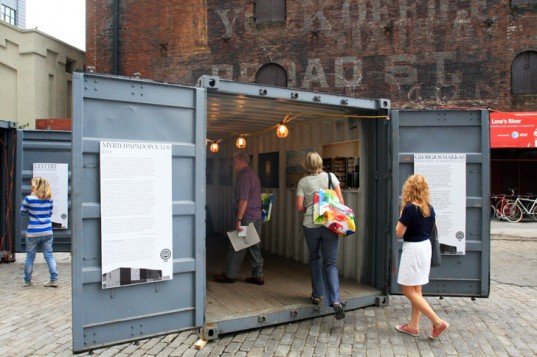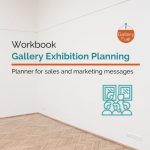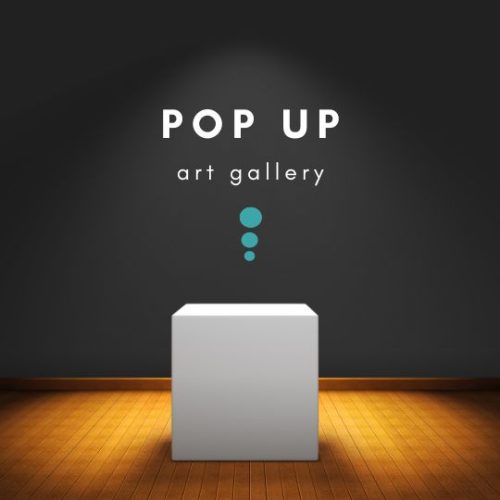The pop-up art gallery continue to be popular as a means for an art gallery business to expand their brand awareness, increase their market and collector base and introduce their artists to new prospects. There is a lot of planning required to have a successful pop-up gallery, but if done well, the rewards will continue long after the pop-up closes.
To make the most of a pop-up gallery, you need to get four key elements right.
- Clear Goals
- Location
- Advertising
- Collector Follow-up
Let’s look at these four success factors in more detail.
Defining Your Pop-up Art Gallery Goals
There are many advantages to trying a pop-up gallery. When defining your gallery’s goal, be very specific about what you hope to achieve. Choose one primary goal to focus on and let that aid you in other decisions you will need to make in the planning process. Your goals might include:
- Expose gallery artists to a new audience
- Find new art collectors
- Increase sales
- Test a new market for expansion.
- Client interaction (great for online-only or seasonal galleries)
- Take better advantage of the holiday season
- Test more experimental art or creative project
- Expand gallery’s brand awareness
While all these may sound tempting, don’t try to achieving them all. Focus in on one that will be the most impactful for your art gallery business. Your chosen goal should drive the location you select, how you advertise and even how you communicate with new contacts when you return to your primary space.
Finding a Great Pop-Up Location
With your goals clearly defined, now it’s time to start looking for a great pop-up location. Consider any resources you might already have within different cities that are a good match for your gallery’s goals. For example, do you know any realtors or other business owners that might benefit from working with your gallery on a short term pop-up? Do you know someone who is a contractor to help prepare the chosen space?
Partnering with an existing business or another gallery has many advantages since they already have a space and customers. Choose one with similar patrons who enjoy luxury and beauty, such as a boutique jewelry store, interior design or architecture firm, luxury car dealership or hotel, high end wine shop or winery.
If utilizing existing relationships is not an option, reach out to residential or commercial real estate agents.
Advantages of Residential Pop-ups
Residential locations are budget friendly and make events more intimate, although the length of time the home is available may be shorter. Listing agents can use the pop up to help market the home and invite past clients to a unique event to say thank you for their business and stay top of mind. Ensure you can draw the right kind of people to a residential location.
Advantages of Commercial Pop-ups
Commercial real estate properties, such as store fronts, allow you more flexibility on the length of time your pop-up gallery will be open and how you can design the space. Chosen wisely, your gallery should have good foot traffic from a commercial space. Commercial listings benefit by collecting a little rent (which is negotiable) on the empty property and by being able to show their location as a usable to space. Another benefit to them is if you agree to do some clean up work to the space in exchange for reduced rent.
There are other options for finding a great location for your pop-up gallery. The kind of space you chose should be directly tied to your goals. Below are a few other options, but certainly not all so think outside the box.

- Shared space with existing business such as those list above
- Event spaces
- Shipping container
- RV
- Rent an event tent
- Buy a booth at a festival or farmers market
Planning Your Pop-up Gallery
As part of your planning process consider how you will encourage visitors to hand over their contact information. Do more than put out a guest book. After all, the opportunity to attract new art collectors is limited to the length of your pop-up, so make the most of it. Find some incentive both before and during the time you will be in this location, such as a raffle to win a piece of artwork or a photo booth where photos get emailed afterwards.
Obviously budget will factor in on how big your gallery can pop. You don’t need to spend a lot of money to be impactful. There are many creative and inexpensive ways to create a pop-up gallery. If your art gallery decides to go with a commercial rental space, consider the rent as a big chunk of your budget. But don’t be afraid to negotiate or barter to help with those costs.
Other Budget considerations include:
- Utilities
- Lighting
- Cleaning and / or paint supplies
- Staff
- Internet access
- Insurance
- Security
- Permits
- Travel
- Signage
- Marketing
- Inventory transportation
- Furniture
- Reception catering
Today there are companies that offer retail spaces in big art markets specifically for a pop-up art gallery. Most of your needs are taken care of by them and there are fewer budget surprises. Check your target location for these kinds of spaces. However, deciding on a venue gives you an opportunity to be creative with how art is presented and the experience viewers enjoy. You have an advantage selecting an unexpected or unusual location.
Advertising Your Pop-up Gallery
Advertising is essential to success. When partnering with another business, create your marketing plan together so expectations for both parties are clearly spelled out up front. Ensure that your partner has information and images far in advance of opening for them to include on their website, social media presence and newsletters.
Make it easy for them to inform their customers what your gallery will be offering and when they can see the artwork.
If you are going it alone, you can start promoting your pop-up gallery with locally focused teasers even before you secure a location. You can also promote your pop-up well in advance with location targeted ads on social media. This is a great way to plant a seed in prospects heads and begin to generate a buzz.
Research all the local advertising opportunities you can find, such as event calendars and publications, journalists, neighborhood magazines and local bloggers. Submit your press release after all the details are finalized.
If you will be in a retail space with foot traffic, create an attention grabbing “Coming soon” banner or sign to hang in the window while the space is being prepared.
After Your Pop-up
Once your temporary pop-up gallery has closed and you return to your regular space, you must continue to nurture the new leads you acquired. Nurturing those that visited your pop-up is where you have great revenue potential for years to come. A follow-up strategy should be planned in advance. You want to immediately start forming solid relationships with these art collectors. Here are some ideas for putting together a follow-process. Mastering the Follow-Up for Art Gallery Sales Leads
Finally, review the goals you set out to achieve and the final budget to determine how successful it was as a business strategy. What could you have done better? What lessons were learned from advertising and location choice? Can your efforts be duplicated in another market? It’s smart to document what went well and what needs improvement. This makes it easier for your next pop-up gallery.
To the Point
There are so many reasons a pop-up art gallery could be good for your art gallery business and there are no limits to how you can do it. The scariest part is the planning of the first one. To make that easier, keep your goals simple and specific. Choose a location that offers your business something your current location may lack.
Don’t push the timeline to be too short for due diligence on location, resources and marketing potential. These are all elements of your pop-up gallery that need to be done well to be profitable. Use the opportunity to take some risks and step outside your comfort zone. You never know which of those risks will pay off tenfold.
Check out these articles too
5 ways to increase foot traffic in an art gallery
Art Gallery Business Development Priorities
 Art Gallery Exhibition Planning Workbook
Art Gallery Exhibition Planning Workbook



Leave a Reply